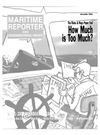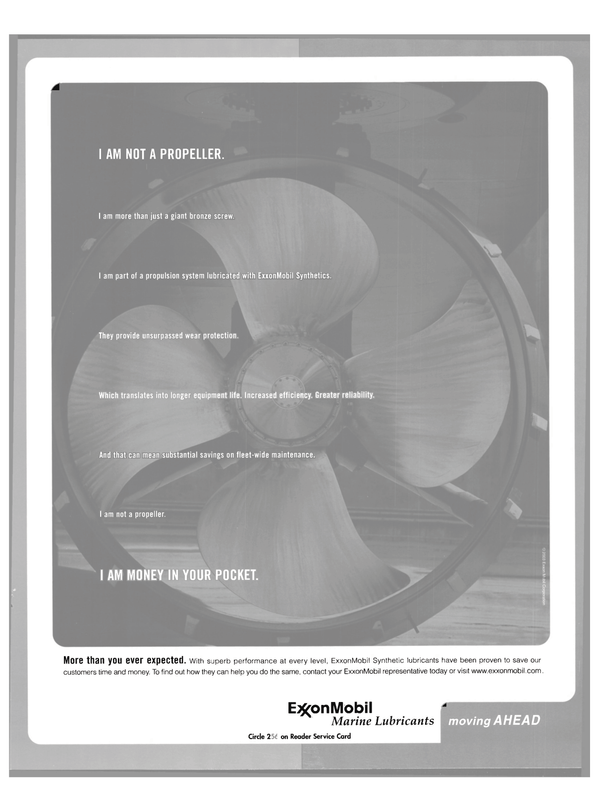
New Aluminum Marine Alloy Specification Developed
ASTM B 928 "High Magnesium Aluminum-Alloy Sheet & Plate for Marine Service" The recent publication of the new specification - ASTM B928 High Magnesium Aluminum-Alloy Sheet & Plate for Marine Service - is the culmination of a cooperative effort between numerous parties involved in the marine industry including aluminum producers, boat builders, the Coast Guard and marine classification societies. The combined work of these groups will help to address the communication gap between marine end users and distributors of aluminum that became apparent in late 2001 /early 2002 in the Pacific Northwest.
As has been reported in various marine industry publications, the performance of some 5083-H321 supplied to Pacific Northwest boat manufacturers indicated that the existing material specifications were insufficient to ensure that the materials used had adequate resistance to all intergranular forms of corrosion. (Please see "Aluminum Gone Bad," Maritime Reporter, May 2003, pg. 44).
There was clearly a need/desire by those impacted, specifically builders of unclassed vessels in domestic service, for a new specification aimed specifically at aluminum sheet and plate products for the marine market. While the impetus for this activity was based largely on material supplied by one mill during an identified time period, it was clear to the aluminum industry and the Coast Guard that this was an issue that was important to all producers of aluminum products for the marine market as well as to the marine industry and the marine classification societies world wide.
While the Aluminum Boat Solutions Team (consisting of aluminum producers, metal service center representatives, the Coast Guard and other representatives from the naval architecture/marine engineering discipline) was created to address the investigate and remediate the specific 5083-H321 problems in the Pacific Northwest, a parallel effort was needed to address the perceived shortcomings in the existing materials specifications.
(Note: A paper discussing the problems experienced by certain Pacific Northwest boat builders and an historical perspective on the development of high Mg aluminum alloys for the marine industry was presented at the SNAME annual meeting in San Francisco in October 2003.) At the request of the Aluminum Boat Solutions Team and with the support of representatives of the U.S. Coast Guard, The Task Group on Marine Alloys was formed in late April of 2002 under the auspices of The Aluminum Association's Technical Committee on Product Standards. The task group's mission was to create a draft document that would expedite the development of a new ASTM material specification - (New ASTM Specifications can frequently take up to two years or more to develop and publish.) This task group consisted of representatives of major aluminum producers that supply products to the global marine industry and was chaired by Michael Skillingberg, VP Technology for The Aluminum Association.
In August of 2002 a draft specification was delivered to ASTM B 07.03, which is the Subcommittee for Aluminum Alloy Wrought Products. While the Task Group at the Aluminum Association had solicited input from classification societies and boat builders during the creation of the draft specification, the ASTM was the appropriate venue for more active participation by the broader community in the development of the new specification. With the help and encouragement of the Coast Guard, additional input was solicited from the marine industry and the classification societies to ensure that the new document would be of practical use and would complement the requirements of the classification societies.
Representatives of aluminum producers, boat builders and classification societies actively participated in the ASTM specification development process, which in addition to electronic distribution and balloting, included two ASTM task group meetings held in conjunction with ASTM committee weeks in November 2002 and May 2003.
Key elements of this new specification (ASTM B 928 "High Magnesium Aluminum-Alloy Sheet & Plate for Marine Service") are the requirements that the referenced materials be capable of meeting the corrosion requirements of both ASTM G 66 (Test Method for Visual Assessment of Exfoliation Corrosion Susceptibility of 5xxx Series Aluminum Alloys (Asset Test)) and ASTM G 67 (Test Method for Determining the Susceptibility to Intergranular Corrosion of 5xxx Series Aluminum Alloys by Mass Loss After Exposure to Nitric Acid (NAMLT Test)). Another significant aspect of the specification is that the requirement applies to both the HI 16 and H321 temper designations for high magnesium aluminum alloys.
Concurrent with the ASTM activities, the Aluminum Association task group continued to meet to supply input on the draft specification as well as to address additional alloy-temper product registrations that will be included in future revisions to ASTM B 928. which are already underway. In addition The Aluminum Association's Technical Committee on Product Standards, which is the North American registrar of alloy-temper product registrations, will restrict the assignment of the HI 16 and H321 temper designations to 5xxx alloys with a nominal magnesium content equal to or greater than 3% and which have the capability of meeting the corrosion requirements of both ASTM G66 and ASTM G67. In the near future, the alloys and tempers covered by ASTM B 928 will be removed from ASTM B 209 making ASTM B 928 the sole ASTM material specification for Marine Sheet and Plate.
At this time, the introduction of this new material specification is for the information of aluminum end-users in the marine industry. It is particularly critical for those building or repairing U.S. Coast Guard certificated commercial vessels in the un-classed domestic market where the Coast Guard does not explicitly regulate either the grade or temper of aluminum, and independent oversight by classification societies rarely is requested. In creating the new specification, it was noted that: • the production of high magnesium aluminum is sensitive to process changes that can have an impact on the corrosion resistance of the particular temper of the aluminum alloy being produced: • not all major classification societies allow the use of 5083 H321. Others that do, had further requirements, such as ensuring the material was coated, when used in salt water applications; • the current and widely used industry practice of specifying aluminum in accordance with ASTM B209 may be insufficient. Further, the commonly accepted H116 temper with ASTM G66 testing only, may not be absolute in guarding against intergranular corrosion, despite its apparent problem free service record over the last 30 or so years.
The Coast Guard intends to review its regulatory scheme and current policy directives to determine the applicability of this new specification. Specifically, comments and information on the domestic industry's experience with aluminum in the marine environment outside the Pacific Northwest, in areas of high activity such as the Gulf Coast, will be solicited to assist the Coast Guard in the evaluation and appropriate application of this specification.
Please contact Marc Cruder mcruder@ comdt.uscg.mil of the Coast Guard's Quality Assurance and Traveling Inspection Staff at Coast Guard Headquarters if you have questions or comments about the regulatory impact of this specification or you would be interested in participating in a working group to reviewise the Coast Guard's current policy guidance regarding aluminum and its use in the construction of inspected small passenger vessels.
Note - The new specification will be available from ASTM International by mid-October at: http://www.astm.org/.
Read New Aluminum Marine Alloy Specification Developed in Pdf, Flash or Html5 edition of November 2003 Maritime Reporter
Other stories from November 2003 issue
Content
- EU Single-Hull Phase-Out Elicits I MO Scorn page: 10
- Costa Victoria in for a Facelift page: 11
- Sustainable Growth for Liner Shipping page: 11
- World's Biggest LNG Carrier Due in 2005 page: 12
- Shipbreaking in the Spotlight at ILO page: 14
- Signet Martime Inks Garrett Contract page: 16
- IZAR Enters Fast Ship Project page: 17
- TEN Signs Time Charter for Aframax Olympia page: 17
- Cruise Port Expenditure to Reach $300M page: 18
- At Sea with U.S. Maritime Security page: 20
- NY Navigation Channels: The Really Big Dig page: 25
- Kvichak Delivers for NY page: 28
- Vosta LMG signs U.S. contract for 18" Cutter Suction Dredge design page: 28
- Senesco Marine Christens New Drydock page: 29
- Workboat Annual 2003 • Great Boats of 2003 page: 30
- Natter Passes Command of Atlantic Fleet page: 41
- Introducing Lean Shipbuilding to U.S. Yards page: 42
- IBM PLM Offers New Shipbuilding Solutions page: 46
- Cosco Dalian Leads China Ship Repair Business page: 50
- China: Growing Influence in All Matters Maritime page: 52
- L'Orange at Marintec China 2003 page: 56
- Shiport China 2004: Set in Tune with the Shipbuilding Industry page: 57
- New Aluminum Marine Alloy Specification Developed page: 58
- InspecTech Launches Line of "Smart" Windows page: 62
- New CEO at Kvaerner Philadelphia page: 62
- Asheim Takes Helm of Hoegh Fleet page: 62
- New Potency in Electronic Control page: 68
- Research as the Building Block page: 70
- Knowledge Interchange page: 71
- Surface-Protection Symposium Set for Liibeck page: 78
- Xybernaut Gets Patent for Detecting Corrosion on Maritime Vessels page: 79
- LCS Hull Concept Tests Move Ahead page: 80
- Hypertherm Enters Laser Cutting Market page: 81
- E-Ship: The Paperless Trail page: 82
- Cradle Tweendecks Patent for Langh Ship page: 86
- Optimizing Feed Rates For Crosshead Diesels page: 88
- Benjamin Vickers: 175 Years & Counting page: 89
- Life Boats by Ernst Hatecke Make the Plunge page: 90
- Clean Seal Celebrates 25 Years page: 91
- Netherlands Vessel First With New Engine page: 92
- ONR To Evaluate SeaCoaster page: 92
- KMY Helps Breaks the Ice in Russia page: 97
- Astander Completes CSO Deep Pioneer Upgrade page: 97
- Rickmers Singapore Christened page: 97
- Transas Releases New Version of Engine Room Simulator page: 98
- Merseyside gets first UK escort tug simulator page: 98


